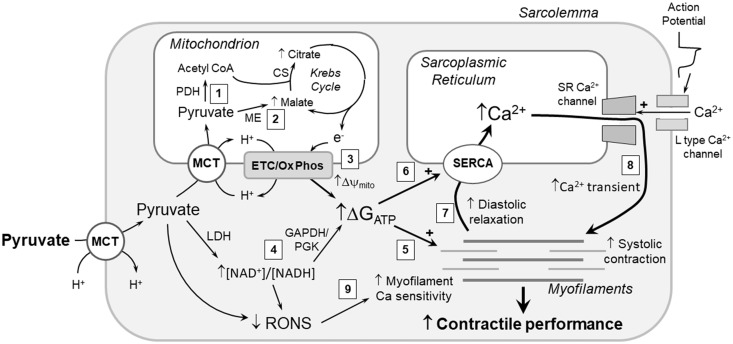Figure 1.
Mechanisms of pyruvate enhancement of myocardial contractile function. Pyruvate’s energy-yielding and antioxidant actions increase cardiac performance by several mechanisms. Pyruvate metabolism increases ΔGATP by (1) generating Krebs cycle substrate acetyl CoA via pyruvate dehydrogenase (PDH); (2) increasing Krebs cycle intermediate pool sizes via anaplerotic pyruvate carboxylation by malic enzyme (ME); (3) augmenting mitochondrial membrane potential (Δψmito); and (4) via lactate dehydrogenase (LDH), increasing cytosolic [NAD+]/[NADH] redox state, which increases ΔGATP via the near-equilibrium glyceraldehyde 3-phosphate dehydrogenase (GAPDH)/phosphoglycerate kinase (PGK) reactions. The increased ΔGATP augments contractile function by providing more energy for (5) myofilament crossbridge cycling and (6) sarcoplasmic reticular (SR) Ca2+ ATPase, i.e. SERCA. Increased SR Ca2+ loading by SERCA facilitates diastolic relaxation of the contractile machinery (7), and, by augmenting SR Ca2+ loading, increases Ca2+ induced Ca2+ release via the ryanodine-sensitive SR Ca2+ channels, producing a greater systolic Ca2+ transient (8) and more robust activation of the myofilaments. Pyruvate’s antioxidant mechanisms, diagramed in detail in Figure 2, remove reactive O2 and N2 species (RONS), thereby augmenting myofilament Ca2+ sensitivity (9). Collectively, these mechanisms enhance both systolic contraction and diastolic relaxation, and thereby increase myocardial contractile performance.CS: citrate synthase; ETC/Ox Phos: electron transport chain/oxidative phosphorylation; MCT: monocarboxylate transporter. See text for details.

